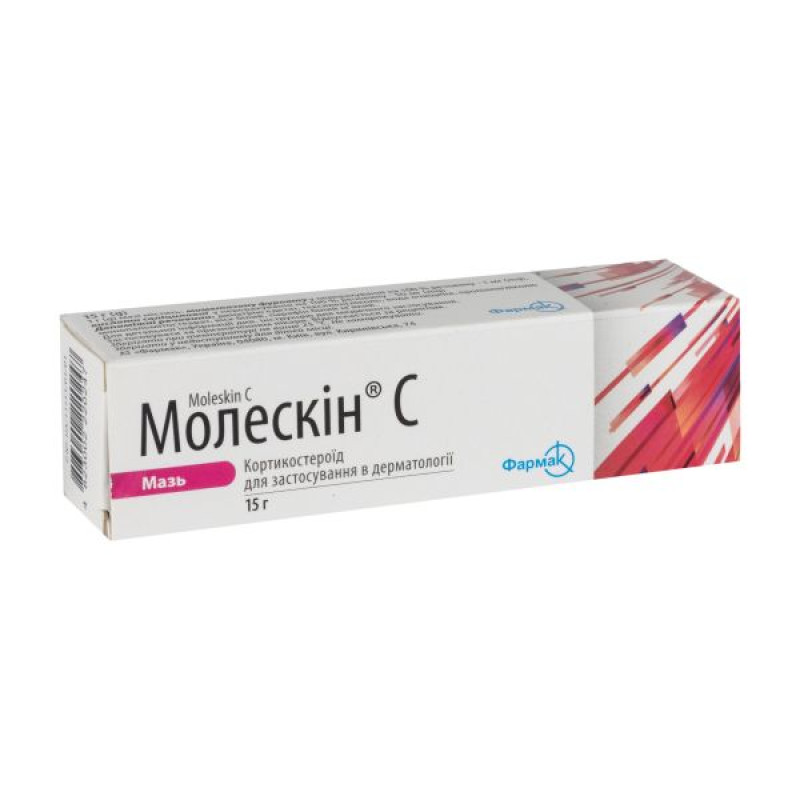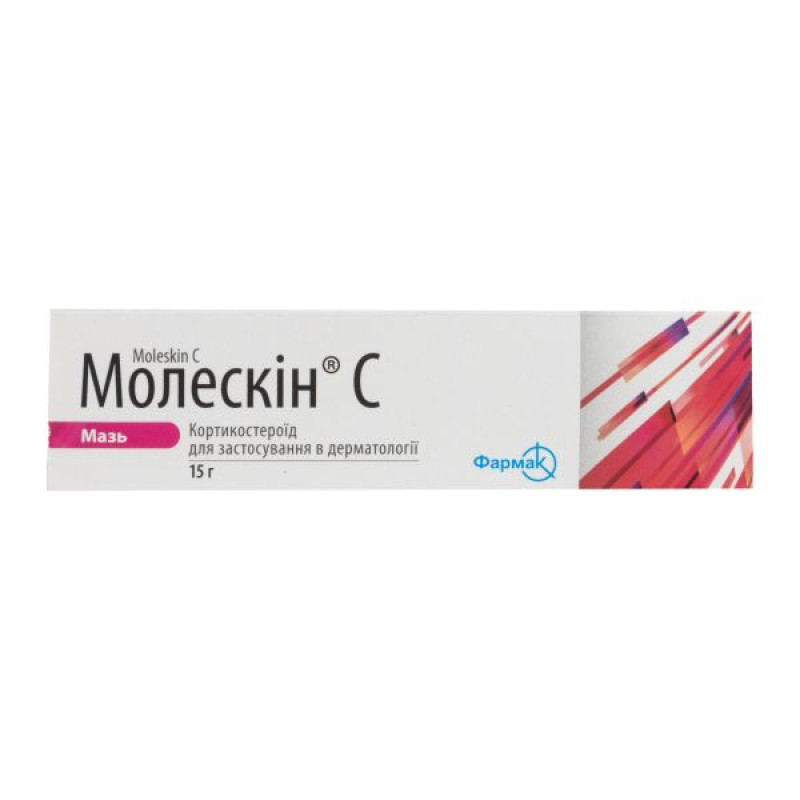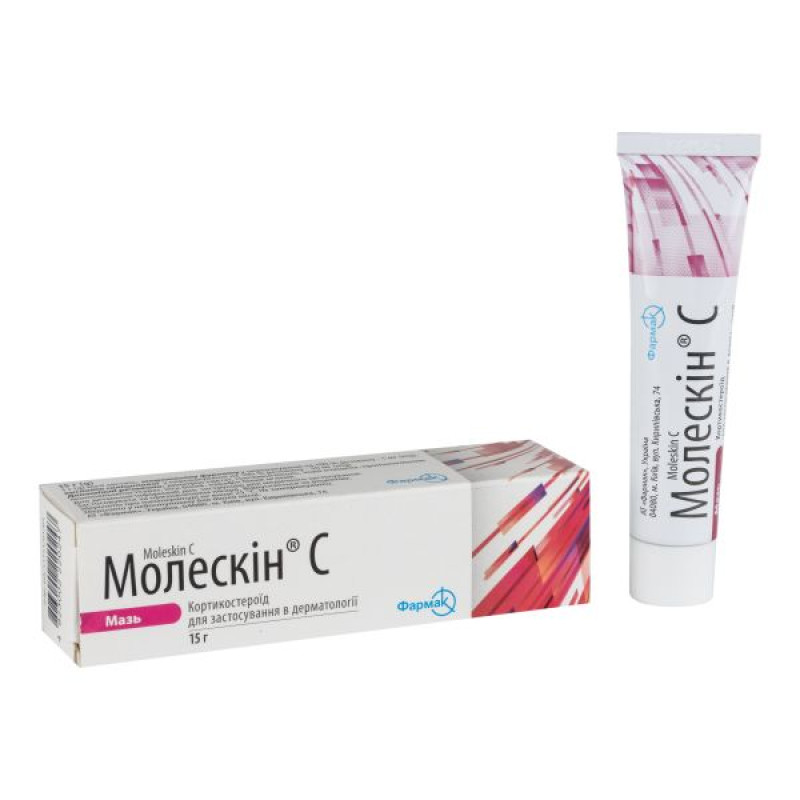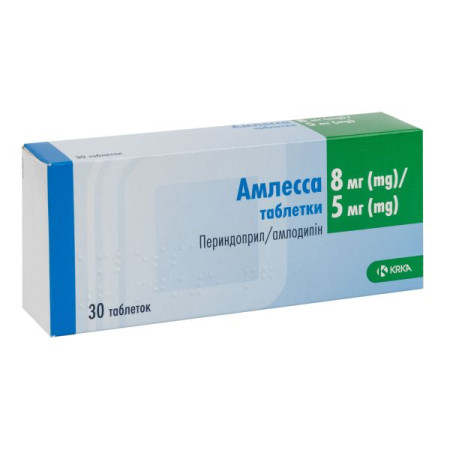Moleskin C ointment tube 15 g

Instructions Moleskin c ointment tube 15 g
Composition
active ingredients: mometasone furoate, salicylic acid;
1 g of ointment contains mometasone furoate 1 mg in terms of 100% substance, salicylic acid 50 mg in terms of 100% substance;
Excipients: disodium edetate, hexylene glycol, purified water, propylene glycol monopalmitostearate, white wax, white soft paraffin.
Dosage form
Ointment.
Main physicochemical properties: homogeneous ointment of white or almost white color.
Pharmacotherapeutic group
Corticosteroids for use in dermatology. Active corticosteroids in combination with other drugs. ATX code D07X C03.
Pharmacological properties
Pharmacodynamics
Mometasone furoate is a potent glucocorticosteroid that has anti-inflammatory, antipruritic, and vasoconstrictor effects. Mometasone furoate is a potent in vitro inhibitor of the production of three cytokines involved in the development and maintenance of the inflammatory process: interleukin-1 (IL-1), interleukin-6 (IL-6), and tumor necrosis factor alpha (TNF-α).
Salicylic acid promotes exfoliation of the stratum corneum and improves the penetration of mometasone furoate into the skin.
Pharmacokinetics
After a single topical application of Moleskin® C ointment for 12 hours without the use of an occlusive dressing, approximately 1.5% of the applied dose is subject to systemic absorption. The drug that has entered the systemic circulation is rapidly excreted in the urine and feces.
Indication
Treatment of moderate to severe plaque psoriasis.
Contraindication
Hypersensitivity to mometasone furoate, salicylic acid or any other component of the drug.
Like other topical glucocorticoids, Moleskin® C is contraindicated in bacterial (including pyoderma, tuberculosis, syphilis), viral (herpes simplex, chickenpox, herpes zoster, warts, condyloma acuminata, molluscum contagiosum) or fungal infections (dermatophytes and yeasts), as well as in parasitic skin diseases, in the absence of concomitant adequate therapy.
Moleskin® C is also contraindicated in post-vaccination reactions, perioral dermatitis or rosacea, common acne, and skin atrophy.
Interaction with other medicinal products and other types of interactions
Following topical application of Moleskin® C, very small but measurable amounts of salicylates were absorbed into the blood plasma. A review of the literature on the interactions of salicylates with other substances after oral administration or application to the skin revealed that the effects of medicinal products such as tolbutamide, methotrexate, heparin, pyrazinamide, uricosuric agents and coumarin-type drugs may be altered. Other glucocorticosteroids and ammonium sulphate may affect the salicylic acid content. This interaction should be taken into account when prescribing Moleskin® C in combination with the above-mentioned medicinal products.
Application features
Moleskin® C is indicated for external use only and is not intended for use in ophthalmology.
As with other topical corticosteroids, appropriate precautions should be taken when applying the ointment to large areas of skin (should not be used in widespread plaque psoriasis) or when long-term treatment is intended. This is especially important in the treatment of children, since children may be more sensitive to hypothalamic-pituitary-adrenal (HPA) suppression and Cushing's syndrome induced by topical corticosteroids than adults, due to greater absorption of the drug due to a higher skin surface area to body weight ratio in children.
Moleskin® C ointment is not recommended for use under occlusive dressings. It should not be applied to the skin of the face or the axillary and inguinal areas, genitals and diaper rash. Avoid contact of the ointment with mucous membranes and open wounds. Moleskin® C should not be used for ulcerative skin lesions, wounds and striae. Moleskin® C is not recommended for use in pustular or guttate psoriasis.
If skin irritation develops, including excessive dryness of the skin, the use of the ointment should be discontinued and adequate therapy should be selected for the patient.
In case of long-term use, it is recommended to gradually withdraw corticosteroids, as corticosteroid withdrawal symptoms (e.g. dermatitis, burning sensation) may occur.
Glucocorticosteroids may mask, stimulate, or worsen skin infections.
If a concomitant skin infection develops, an appropriate antifungal or antimicrobial agent should be used. If a rapid response to treatment is not achieved, the use of Moleskin® C ointment should be discontinued until the infection has been adequately resolved.
Any side effects seen with systemic corticosteroids, including adrenal suppression, may also occur with topical glucocorticosteroids, especially in infants and children.
Moleskin® C contains propylene glycol monopalmitostearate, which may cause skin irritation.
Ability to influence reaction speed when driving vehicles or other mechanisms
Usually the drug does not affect the reaction speed when driving or working with other mechanisms.
Use during pregnancy or breastfeeding
Controlled studies on the use of the drug during pregnancy have not been conducted. Moleskin® C ointment should not be prescribed in the I-II trimesters of pregnancy. Moleskin® C is contraindicated during the III trimester of pregnancy.
It is not known whether topical application of corticosteroids or salicylic acid may lead to their penetration into breast milk through systemic absorption, therefore Moleskin® C is not recommended for use in women during breastfeeding.
Method of administration and doses
Adults and children over 12 years of age apply a thin layer of ointment to the affected skin surface 1 or 2 times a day (morning and/or evening). The maximum daily dose is 15 g, which is applied to no more than 30% of the body surface. The duration of treatment is determined by the doctor depending on the severity and course of the disease. The duration of treatment for more than 3 weeks has not been evaluated in the main studies. As with all potent glucocorticosteroids, it is recommended to gradually reduce the dose of application.
Children
The safety and efficacy of Moleskin® C in children under 12 years of age have not been established. Children should receive the minimum amount of glucocorticosteroid to achieve the desired effect. Long-term treatment with glucocorticosteroids may adversely affect growth and development in children.
Overdose
Excessive or prolonged use of topical corticosteroids may cause suppression of pituitary-adrenal function, and as a result may cause the development of secondary adrenal insufficiency and the appearance of symptoms of hypercorticism, including Cushing's syndrome.
Treatment: If signs of hypothalamic-pituitary-adrenal axis suppression appear, an attempt should be made to reduce the frequency of application of the drug or discontinue its use. Appropriate symptomatic therapy should also be prescribed.
In the clinical program, doses exceeding the recommended maximum daily dose of 15 g per day had a transient effect on the function of the hypothalamic-pituitary-adrenal axis.
When applied to large areas of skin, systemic effects characteristic of salicylic acid may occur. In case of toxicity caused by salicylic acid, the use of Moleskin® C should be discontinued. Fluids are prescribed to induce diuresis. Sodium bicarbonate and potassium are prescribed (oral or intravenous) if necessary.
Adverse reactions
The following adverse reactions have been reported with the use of topical corticosteroids: very common (≥ 1/10); common (≥ 1/100, < 1/10); uncommon (≥ 1/1000, < 1/100); rare
(≥ 1/10,000, < 1/1,000); very rare (< 1/10,000, including isolated reports).
On the part of the endocrine system: rarely - suppression of adrenal function.
Skin and subcutaneous tissue disorders: common: itching, local skin atrophy; uncommon: striae, rosacea-like dermatitis, ecchymosis, folliculitis, furunculosis; rare: hypertrichosis, skin hypopigmentation; not known: skin irritation, skin maceration, dry skin, acneiform dermatitis, dermatitis, contact dermatitis, skin peeling, telangiectasia, sweating.
General disorders and administration site conditions: common: burning sensation at the application site, tingling.
Infections and infestations: uncommon – infections.
On the part of the immune system: rarely - hypersensitivity.
In addition, perioral dermatitis has been reported infrequently as an additional side effect with the use of topical corticosteroids.
Prolonged continuous use of topical corticosteroids may cause the development of local skin atrophy, striae, and dilation of superficial vessels, especially on the face.
Prolonged use of medications containing salicylic acid can cause dermatitis.
Expiration date
2 years.
Do not use the drug after the expiration date indicated on the package.
Storage conditions
Store at a temperature not exceeding 25 ° C. Do not freeze.
Keep out of reach of children.
Packaging
15 g in a tube. 1 tube in a pack.
Vacation category
According to the recipe.
Producer
JSC "Farmak".
Location of the manufacturer and its business address
Ukraine, 04080, Kyiv, Kyrylivska St., 74.
There are no reviews for this product.
There are no reviews for this product, be the first to leave your review.
No questions about this product, be the first and ask your question.











